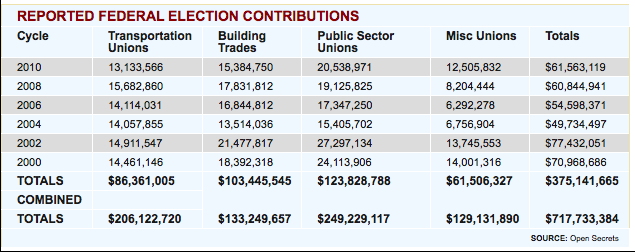The conflagration in Wisconsin isn’t about workers rights. It is about money. But it is not about the payroll and benefits of union members, it is about the lavish salaries of union leadership, and their ability to continue to fund the political activities that allows them to precariously hang on to their source of income – dues from members, be they public- or private-sector employees. The Center for Public Integrity evaluated the assets, compensation and political spending of the 10 largest unions. The reports show that assets of the various labor unions run into the hundreds of millions of dollars, and payrolls rival midsize companies. Dozens of top officials have salary-and-benefit packages that rank them among the top percentage of income-earners in the country. Additional benefits for these top officials can include tens of thousands of dollars for meal allowances, mileage allowances and entertainment. And the financial documents filed by unions with the DOL don’t disclose healthcare and pension contributions. “What’s very clear to union leaders is the huge threat this poses for the organizations they have built,” said John C. McAdams, political science professor at Marquette University in Wisconsin. Here is a quick snapshot of the Top 10 unions. The political spending is for the last election cycle only: National Education Association Assets: $216 Million Staff earning over $200,000: 31 President’s salary: $397,721 Political Spending: $3.7 million (98% to Democrats) Service Employees International Union Assets: $187 Million Staff earning over $200,000: 9 President’s salary: $306,388 Political Spending: $2 million (99.99% to Democrats) United Food & Commercial Workers Assets: $157 Million Staff earning over $200,000: 17 Staff earning over $100,000: 250 President’s salary: $360,737 Political Spending: $1.9 million (99% to Democrats) Teamsters Assets: $175 Million Staff earning over $200,000: 8 President’s salary: $362,869 Political Spending: $2.3 million (99.99% to Democrats) AFSCME Assets: $97 Million Staff earning over $200,000: 10 President’s salary: $479,328 Political Spending: $2.3 million (99.99% to Democrats) Laborers Assets: $134 Million Staff earning over $200,000: 18 Staff earning over $300,000: 11 President’s salary: $618,000 Political Spending: $1.7 million (95% to Democrats) American Federation of Teachers Assets: $115 Million Staff earning over $200,000: 9 President’s salary: $428,284 Political Spending: $2.4 million (99.99% to Democrats) International Brotherhood of Electrical Workers Assets: $482 Million Staff earning over $200,000: 16 President’s salary: $375,767 International Association of Machinists and Aerospace Workers Assets: $147 Million Staff earning over $200,000: 34 President’s salary: $284,975 Political Spending: $2 million (99.99% to Democrats) United Auto Workers Assets: $1.2 BILLION Staff earning over $200,000: 0 President’s salary: $173,065 Political Spending: $1.6 million (99.99% to Democrats) In a related story by the WashingtonExaminer.com, Ron Arnold introduces us to “the three most powerful Big Labor bosses you never heard of.” He is referring to the political directors of three of the most active and heavily spending Big Labor organizations, Karen Ackerman of the AFL-CIO (recently deposed by the mid-term election “disaster”), Larry Scanlon of AFSCME, and Jon Youngdahl of SEIU. Included in the article were the following charts obtained form OpenSecrets.org:
These political directors, and others at unions across the country, apparently have a new tool designed to stretch their political spending dollars. As described by Arnold, the Atlas Project “brings together supercomputerized databases tailored to the unique nature of the states and districts where the toughest battles are fought, instructions on writing a winning campaign plan, past election results, absentee voting laws, public media spending, filing deadlines, how to reach opinion leaders – a treasure trove political directors need.”






